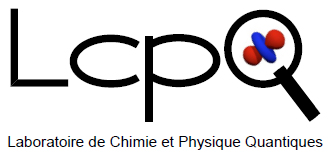Computational photochemistry of organic molecular crystals
THEORETICAL CHEMISTRY AND COMPUTATIONAL MODELING

Lab: LCPQ
Duration: NanoX master Internship (8 months part-time in-lab immersion),
5 months full-time internship,
6 months full-time internship
Latest starting date: 03/01/2022
Localisation: LABORATOIRE DE CHIMIE ET PHYSIQUE QUANTIQUES, UNIVERSITÉ PAUL SABATIER, BÂT. 3R1b4, 118 ROUTE DE NARBONNE, 31062 TOULOUSE, FRANCE
Supervisors:
Martial BOGGIO-PASQUA, Dr. martial.boggio@irsamc.ups-tlse.fr
/ a@a
This research master's degree project could be followed by a PhD
Work package:
Understanding photoinduced processes in organic molecular crystals is central to the design of highly emissive materials such as organic light-emitting diodes,[1] and multicolored photochromic materials with application for photoswitchable full-color displays and multifrequency three-dimensional optical memory media.[2] However, the rationalization of the photochemical behavior is still poorly understood at the solid-state level because of the difficulty to model photochemical pathways in crystal environments. In particular, radiationless decay through conical intersections (CIs) is ubiquitous in photochemical processes.[3] CIs not only provide critical structures acting as funnels for efficient non-radiative transitions between electronic states leading to the formation of photoproducts not reachable by thermal (ground-state) processes, but they are also at the origin of emission quenching depending on their accessibility on the excited-state potential energy surface.[4]
While computational photochemistry has been highly successful in studying various photochemical processes in the gas phase, in solution and even in complex biological environments,[5] it has rarely been applied in the context of molecular crystals. This can mainly be explained by the lack of excited-state methodologies tailored for such periodic systems. Recently, embedding approaches based on the Ewald sum have been used in conjunction with excited-state electronic structure methods to model the localized excitations which characterize these materials.[6,7]
During this internship, we aim at using different embedding schemes to study aggregation-induced emissions in different organic molecular crystals using either benzylideneimidazolinone[8] or cinnamoyle pyrone[9] derivatives. We will first use the point charge embedding (PCE) approach where only the Coulomb interactions are considered, using point charges, and nonelectrostatic interactions are neglected.[6] Then, we will explore the possibility to increase the size of the quantum mechanical system to several chromophore units by using a cluster approach in combination with the PCE approach. Eventually, if time allows, we will use hybrid QM/QM’ electrostatic embedding schemes in order to account for the polarization of the environment.[7] The purpose of these computational studies will be to rationalize the solid-state luminescence enhancement observed experimentally compared to the behavior in the gas phase or in solution.
References:
[1] S.-J. Zou, Y. Shen, F.-M. Xie, J.-D. Chen, Y.-Q. Li, J.-X. Tang, Mater. Chem. Front. 2020, 4, 788–820.
[2] M. Irie, T. Fukaminato, K. Matsuda, S. Kobatake, Chem. Rev. 2014, 114, 12174–12277.
[3] F. Bernardi, M. Olivucci, M. A. Robb, Chem. Soc. Rev. 1996, 25, 321–328.
[4] R. Crespo-Otero, Q. Li, L. Blancafort, Chem. Asian J. 2019, 14, 700.
[5] S. Mai, L. González, Angew. Chem. Int. Ed. 2020, 59, 16832–16846.
[6] A. Severo Pereira Gomes, C. R. Jacob, Annu. Rep. Prog. Chem., Sect. C: Phys. Chem. 2012, 108, 222−277.
[7] M. Rivera, M. Dommett, R. Crespo-Otero, J. Chem. Theory Comput. 2019, 15, 2504–2516.
[8] C. Carayon, C. André-Barrès, N. Leygue, N. Saffon-Merceron, M. Boggio-Pasqua, S. Fery-Forgues, Dyes Pigment. 2021, 187, 109119.
[9] D. O. Tykhanov, E. V. Sanin, O. V. Grygorovych, I. I. Serikova, F. G. Yaremenko, A. D. Roshal, Funct. Mater. 2011, 18, 339.
Areas of expertise:
THEORETICAL PHOTOCHEMISTRY, AGGREGATION-INDUCED EMISSION
Required skills for the internship:
QUANTUM CHEMISTRY, ELECTRONIC STRUCTURE METHODS
